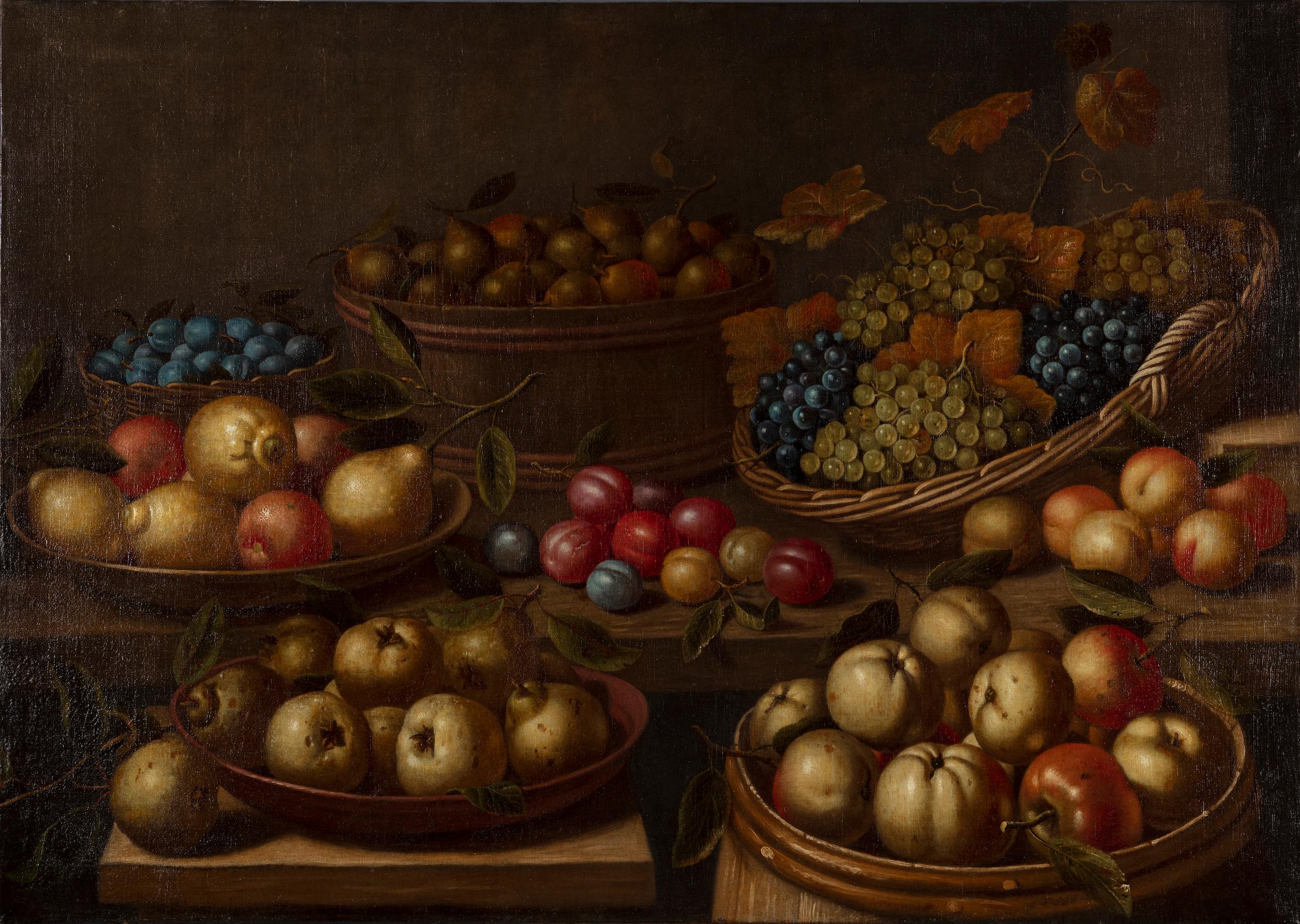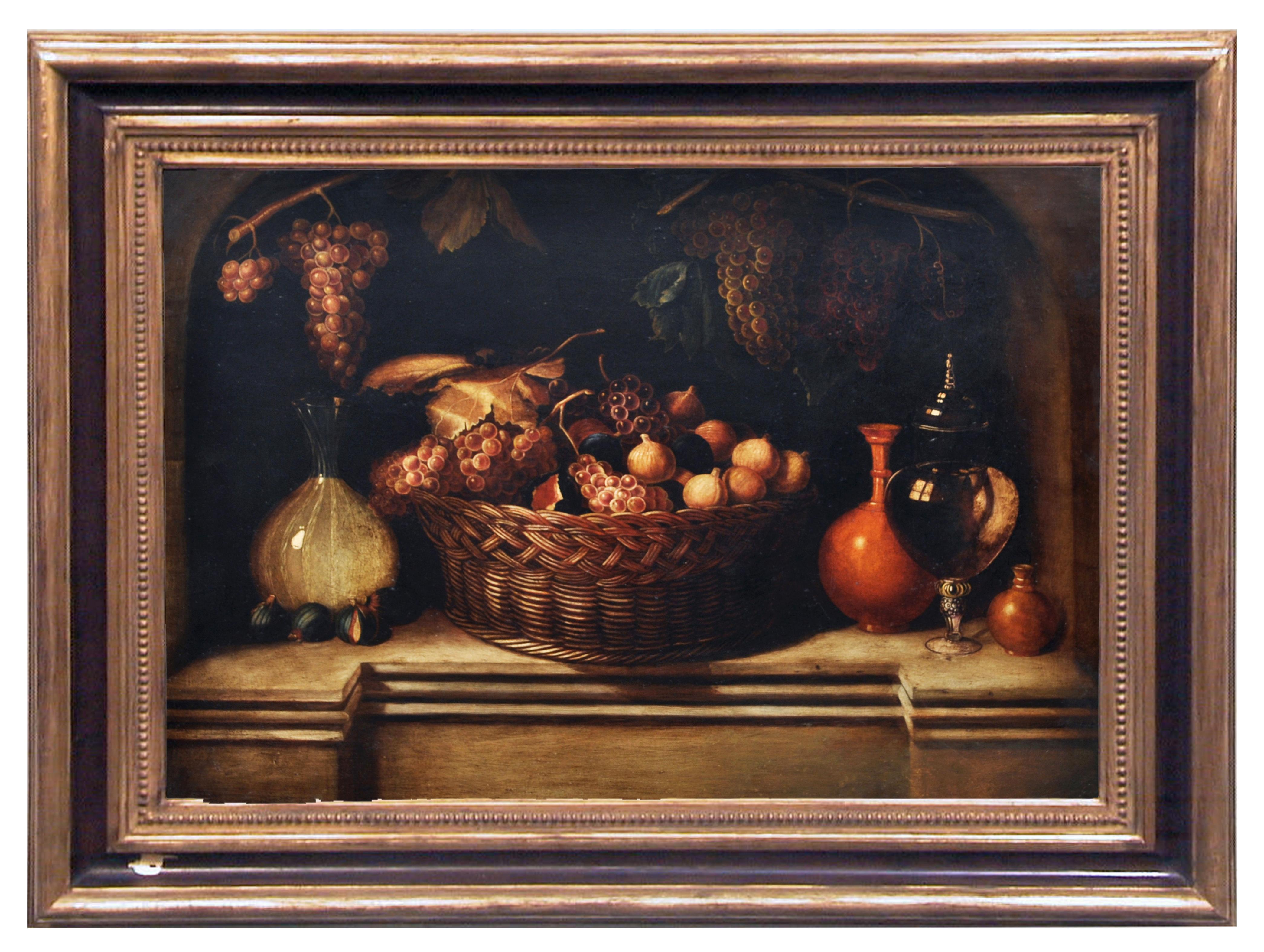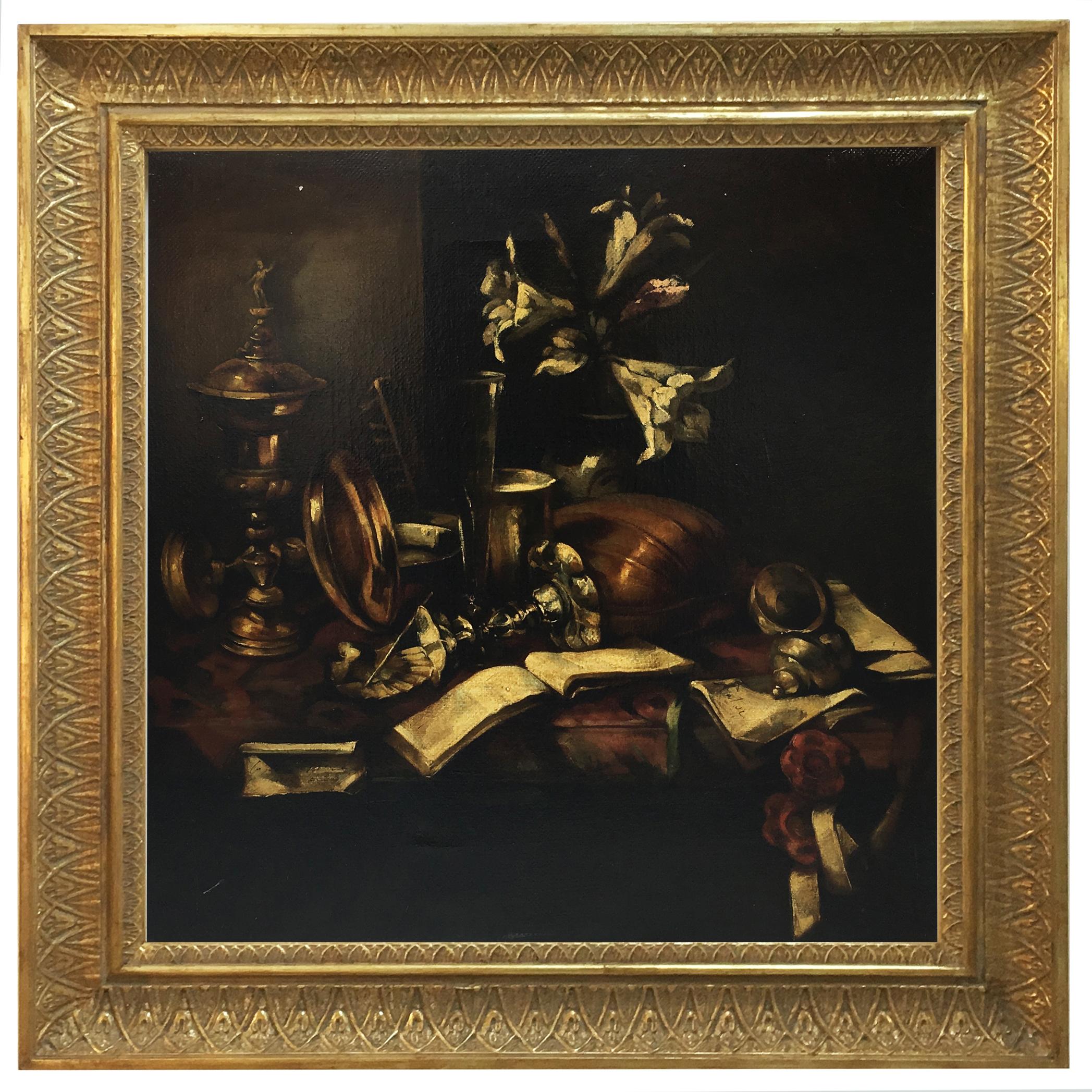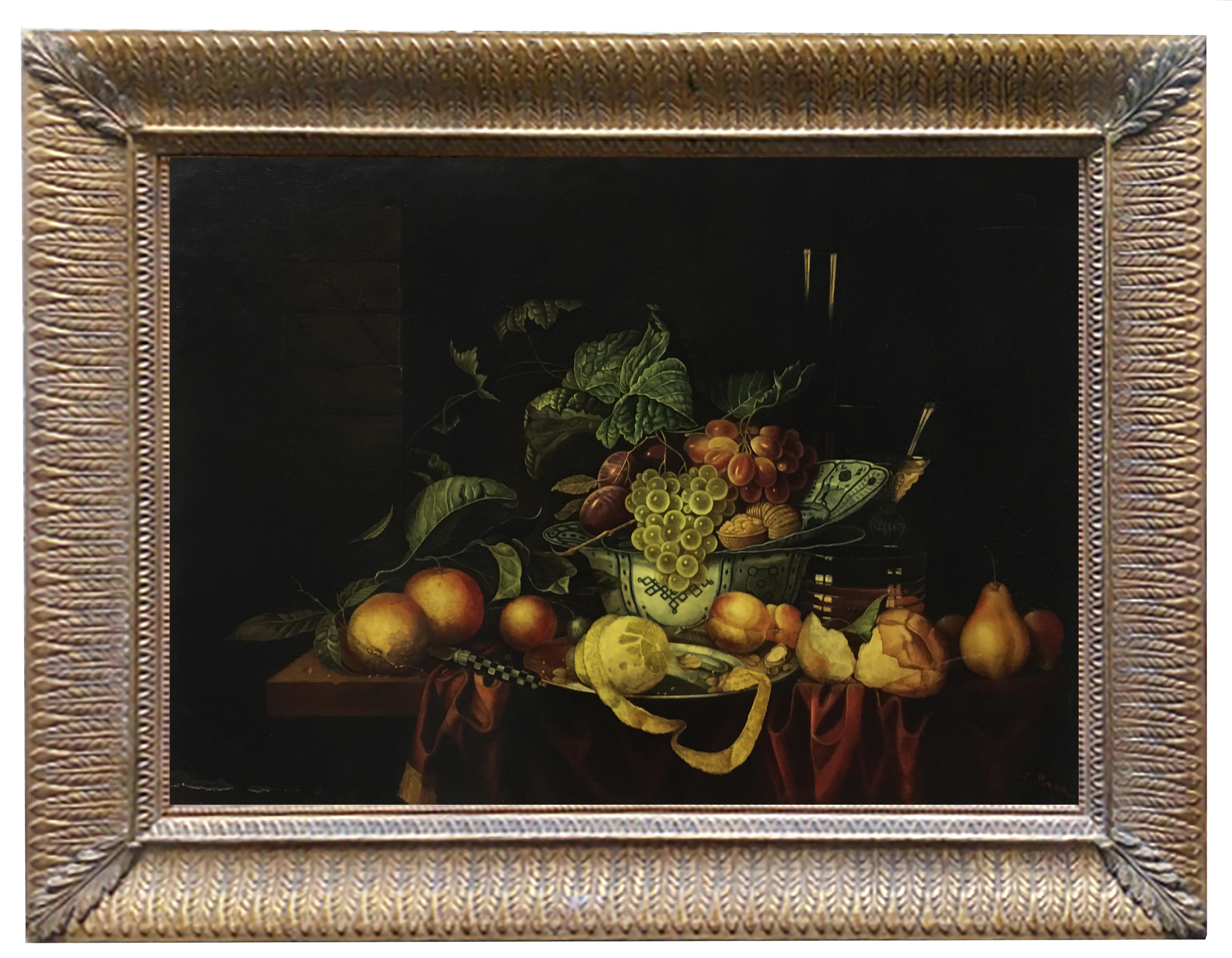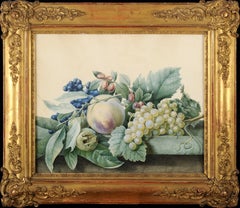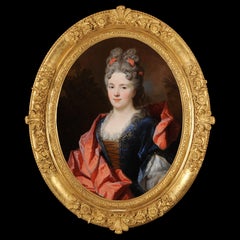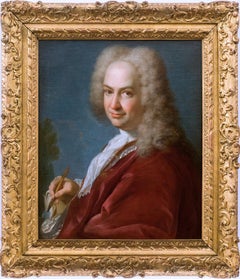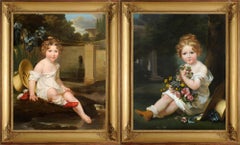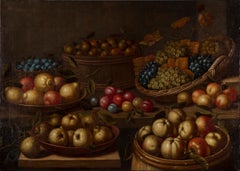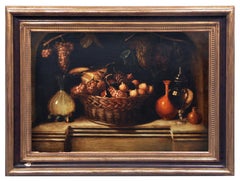Items Similar to Still-life of various art objects
Want more images or videos?
Request additional images or videos from the seller
1 of 8
François Carlier-RubrecqStill-life of various art objects1825
1825
$7,827.21
£5,791.16
€6,500
CA$10,822.51
A$11,881.77
CHF 6,198.74
MX$143,785.95
NOK 77,691.64
SEK 73,205.95
DKK 49,491.18
About the Item
François CARLIER-RUBRECQ
(active around 1820-1830)
Study of various works of art
Oil on canvas
H. 50 cm; L. 58.5 cm
Signed and dated upper left, countersigned on the stretcher 1825
Exhibition : Salon de Lille of 1825, N ° 822 of the booklet
The author of our work is most probably the son of Pierre-Joseph Carlier , the restorer of paintings who worked for the administration of the Louvre, notably under the direction of Fereol Bonnemaison and the Count of Forbin at the time of Louis XVIII. François-Joseph-Marie Carlier also became a restorer of paintings, in Lille, where he is referenced as such in 1819. He was married there in 1811 to Adeline-Charlotte-Désirée-Joseph Rubrecq, and had attached to his name that of his wife, as was often the case at the time. We know that he exhibited his productions, portraits and genre scenes, in various salons in the north of France: in Lille in 1822 and 1825, in Douai in 1823 and 1829, in Valenciennes in 1833. His son Victor Carlier kissed also a painter's career, and exhibited at the Salons of Valenciennes and Arras in 1833.
This still life brings together, on a green cloth carpet, some plant elements (a rose and cherries), but above all of decorative art: a child's head carved in the antique style, a small bronze bust of Henri IV (a reference to the return of the Bourbons, which situates the painting in its time), two pearl necklaces, a glass and a crystal decanter, a wind musical instrument (probably an oboe), as well as two pieces of goldsmith's work. In the Dutch style of the 17th century, the artist has a window reflected in the crystal of the decanter and in the silver ewer; this one also returns the image of several objects of the composition and, funny detail, that of the artist. Several probable influences can be detected in this original composition by an artist unknown to this day. Clara Peeters (1594-after 1657) with her beautiful regular layouts mixing fruits, flowers, glassware and pieces of silverware; Thomas-Germain Duvivier (1735-1814), who often introduced sculptures in marble or plaster in his silent compositions dedicated to the arts and music; Johann-Rudolf Feyerabend, dit Lelong (1779-1814), and his rows of heterogeneous objects (vases of flowers, card games, pastries, bird cages, musical instruments, coffee sets, etc.) in gouaches of small format.
We can explain these influences by the solid knowledge of painting that Carlier-Rubrecq had built up, not only thanks to his activity as a restorer of paintings (and that of his father), but also as a collector (he exhibited several paintings belonging to the Lille exhibition of 1835, including a Van Veen, a de Heem, or a Savery).
- Creator:François Carlier-Rubrecq (French)
- Creation Year:1825
- Dimensions:Height: 19.69 in (50 cm)Width: 23.04 in (58.5 cm)
- Medium:
- Movement & Style:
- Period:
- Condition:
- Gallery Location:BELEYMAS, FR
- Reference Number:1stDibs: LU1857215924232
About the Seller
3.0
Vetted Professional Seller
Every seller passes strict standards for authenticity and reliability
Established in 2017
1stDibs seller since 2022
5 sales on 1stDibs
- ShippingRetrieving quote...Shipping from: BELEYMAS, France
- Return Policy
Authenticity Guarantee
In the unlikely event there’s an issue with an item’s authenticity, contact us within 1 year for a full refund. DetailsMoney-Back Guarantee
If your item is not as described, is damaged in transit, or does not arrive, contact us within 7 days for a full refund. Details24-Hour Cancellation
You have a 24-hour grace period in which to reconsider your purchase, with no questions asked.Vetted Professional Sellers
Our world-class sellers must adhere to strict standards for service and quality, maintaining the integrity of our listings.Price-Match Guarantee
If you find that a seller listed the same item for a lower price elsewhere, we’ll match it.Trusted Global Delivery
Our best-in-class carrier network provides specialized shipping options worldwide, including custom delivery.More From This Seller
View AllStill-life of fruits on a marble entablature
Located in BELEYMAS, FR
Attributed to Pancrace BESSA
(1772-1846)
Fruits on a marble entablature
Watercolor and graphite on paper
H. 31 cm; W. 37 cm
Category
1830s French School Still-life Paintings
Materials
Paper, Watercolor
Presumed portrait of Marie-Anne de Bourbon
By Nicolas de Largillière
Located in BELEYMAS, FR
Nicolas de LARGILLIERRE
(Paris 1656 – 1746)
Portrait of a woman, presumed to be Marie-Anne de Bourbon, Princess of Conti (1666-1739)
Oil on oval canvas
H. 8...
Category
Early 1700s French School Figurative Paintings
Materials
Canvas, Oil
Presumed artist self-portrait
Located in BELEYMAS, FR
Louis-Gabriel BLANCHET
(Versailles, 1701 – Rome, 1772)
Presumed self-portrait of the artist
Oil on canvas
H. 73 cm; W. 60 cm
Circa 1730
Originally presented in a Restoration period frame with a "Mignard" cartouche, this beautiful painting initially appeared to us as a work from northern Italy. However, it exuded a rather French form of refinement, suggesting that its artist may have assimilated a dual influence from both sides of the Alps.
We thank our colleague and friend Philippe Mendès for spontaneously and judiciously "bringing out" the name of Louis-Gabriel Blanchet, a Romanized French portraitist, whose spirit and stylistic characteristics we clearly recognize here.
Blanchet's "French" years, before his final departure for Rome in 1728, following his winning of the second Grand Prix for painting after Subleyras in 1727, are extremely poorly documented. His father, Gabriel, was valet to Blouin, himself Louis XIV's first valet at the time. According to Thierry Lefrançois, Blanchet was one of the few students of Nicolas Bertin (1667-1736), whose studio he is said to have joined in the early 1720s. At a baptism on March 24, 1724, where he was godfather, he is mentioned as a painter in the picture store of the Duke of Antin, the director of buildings between 1708 and 1736. At this time, he was probably already married to Jeanne Quément, with whom he had a daughter also named Jeanne, who would marry Nicolas Aviet, the son of a valet in the queen's wardrobe, in Versailles in 1738.
When Blanchet arrived in Rome in October 1728, he was accompanied by Subleyras, Trémolières, and Slodtz. He enjoyed the goodwill of Vleughels, the director of the Académie de France, which had been based at the Palazzo Mancini since 1725, even though the latter was not always kind to our resident. From 1732, he was under the protection of the Duke of Saint-Aignan when he took up his post as ambassador to Rome. Along with Slodtz and Subleyras, they formed a trio of friends, joined by Joseph Vernet shortly after his arrival in Rome in 1734. Slodtz and Blanchet, on the occasion of Subleyras's marriage in 1739, were there to attest that their friend was not bound by any marital commitment, and Blanchet was a witness at Vernet's wedding in 1745.
It is most likely from these early years in Rome that our portrait of the artist dates, the expression and turn of his face irresistibly reminiscent of a self-portrait. The still relatively youthful features may correspond to Blanchet's thirty-something years, and the fluffy wig was still fashionable at this time.
The painting fits well with the depiction of a young painter wanting to display both the beginnings of success and a certain simplicity or restraint. A slight smile expresses a form of assurance in this man with a gentle, sincere gaze and a face radiating a keen sense of wit. We find here the air of intimacy present in almost all of Blanchet's portraits, even those from the 1750s and 1760s, as well as an almost complicity with the viewer. The spirit of the painting is quite close to that of the presumed portrait of Bouchardon (painted around 1730) and the portrait of Pannini, painted in 1736, but it possesses a more natural quality, notably thanks to the absence of decorum. Our work exhibits the characteristics of Blanchet's paintings: elegance, luminosity (especially in the whites), vibrant and refined colors (here, the harmony of the garnet of the garment and the slate blue of the background, whose uniformity is tempered by a very sketched landscape and a grove of greenery), light complexions, rather rosy cheekbones, often full lips, and rather tight framing.
According to the Academy's rules, Blanchet's stay should have ended in the spring of 1732, but, for reasons unknown, he remained in the Eternal City until his death, as did his friend Subleyras, with whom he shared accommodation until the late 1730s. The latter regularly called upon him to collaborate on his paintings, such as The Meal at Simon's. Through Saint-Aignan's intervention, Blanchet was employed in the late 1730s by the Stuart princely family, then exiled in Italy. He notably produced copies (now lost) after Liotard of the portraits of Charles Edward and Henry Benedict, the sons of James III Stuart. The latter also commissioned three other portraits (now in the National Portrait Gallery in London), whose more formal character contrasts with the intimate spirit of Blanchet's portraits. Blanchet frequented English painters, such as the landscape painter Richard Wilson, and studied with the Scottish portraitist Katherine Read...
Category
1730s French School Portrait Paintings
Materials
Oil, Canvas
Portraits of two sisters
Located in BELEYMAS, FR
Bernard GAILLOT
(Versailles 1780 – Paris, 1847)
Portraits of two sisters
Pair of oil on canvas
H. 92 cm; L. 73 cm
One signed
Student of David, he presented his first works at the Sa...
Category
1810s French School Portrait Paintings
Materials
Canvas, Oil
Portrait of a young woman in Louis XV period dress
Located in BELEYMAS, FR
French School
Portrait of a young woman in Louis XV period dress
Pastel on paper mounted on oval canvas
H. 68 cm; W. 54 cm (Frame: H. 102 cm; W. 71 cm)
18th century frame, anti-refle...
Category
Mid-18th Century French School Figurative Paintings
Materials
Canvas, Paper, Pastel
Portrait of a couple
Located in BELEYMAS, FR
Jean-Baptiste SANTERRE
(Magny en Véxins 1651 - Paris 1717)
Portrait of a couple
Oil on original oval canvas
H. 115 cm; L. 90 cm (140 x 115 cm with frame)
Around 1695
Jean-Baptiste S...
Category
1690s French School Portrait Paintings
Materials
Canvas, Oil
You May Also Like
STILL LIFE - Giovanni Bonetti - Still Life Oil on Canvas Painting
By Giovanni Bonetti
Located in Napoli, IT
Still life - Oil on canvas cm.80x100, Giovanni Bonetti, Italy 2003
In this very precious oil on canvas, Giovanni Bonetti is inspired by the XVIII flowery compositions painted by the...
Category
Early 2000s Dutch School Still-life Paintings
Materials
Canvas, Oil
STILL LIFE - Massimo Reggiani - Oil on Canvas Italian Painting
By Massimo Reggiani
Located in Napoli, IT
STILL LIFE - Oil on canvas cm. 40x50 by Massimo Reggiani, Italy 2005
Still life, a pictorial representation of foodstuffs, objects or inanimate objects, was one of the artistic genres that became completely independent in the seventeenth century. Reggiani has composed this still life inspired by the Dutch school. Fruit, grapes and peaches...
Category
21st Century and Contemporary Old Masters Still-life Paintings
Materials
Canvas, Oil
Still Life
Located in Paris, Île-de-France
Floris van Schooten (1585/88-1656)
Still Life
Oil on canvas, 121 x 85 cm
Provenance:
Private Collection
Floris van Schooten, a Dutch painter mainly active in Haarlem, is renowned ...
Category
1630s Baroque Still-life Paintings
Materials
Canvas, Oil
STILL LIFE - Dutch School -Italian Oil on Canvas Painting
By Giovanni Perna
Located in Napoli, IT
Still life - Giovanni Perna Italia 2004 - Oil on canvas cm.50x70
in this beautiful oil on canvas Giovanni Perna was inspired by the paintings of the Spanish painter of Dutch origin J...
Category
Early 2000s Dutch School Still-life Paintings
Materials
Canvas, Oil
Still Life - Francesca Strino Italian oil on canvas painting
By Francesca Strino
Located in Napoli, IT
Still life - Francesca Strino Italia 2005 - Oil on canvas cm.60x60
Francesca Strino, a Neapolitan painter, realises this still life with great pictorial realism. The painter has her ...
Category
Early 2000s Old Masters Still-life Paintings
Materials
Canvas, Oil
STILL LIFE - Dutch School - Oil on Canvas Italian Painting
By Giovanni Perna
Located in Napoli, IT
Still life - Giovanni Perna Italia 2008 - Oil on canvas cm.50x70
In this beautiful oil on canvas Giovanni Perna was inspired by the paintings of the Spanish painter of Dutch origin Juan van der Hamen, famous for his production of still lifes In particular, this painting depicts an elegant terracotta fruit...
Category
Early 2000s Dutch School Still-life Paintings
Materials
Canvas, Oil
More Ways To Browse
Antique Stills
Louis Xviii
Clara Antique
Glass Pearl Necklace
Henri Iv
Plaster Bust Of A Child
Van Veen
Antique Still Life With Cherries
Clara Peeters
Americas Cup Oil Painting
Brian William
Carol Stewart
Dennis Perrin
Donut Still Life
Floral Still Life 1930
Flower Black Background Art
Jean Baptiste Monnoyer
Jesus Navarro


